Dynamics of Coastal Aquifers: Conceptualization and Steady-State Calibration of Multilayer Aquifer System—Southern Coast of Emilia Romagna
Abstract
:1. Introduction
2. Materials and Methods
2.1. Study Area
2.2. Geomorphology of the Study Area
2.3. Litho-Stratigraphic Units and Hydrogeology of the Area
2.4. Hydrogeology of the Study Area
2.5. Numerical Model Development
3. Results
3.1. Lithology and Hydrogeological Characterization
3.2. Surface Water Simulation
3.3. Model Conceptualization
3.4. Model Calibration
4. Discussion
5. Summary and Conclusions
Author Contributions
Funding
Data Availability Statement
Acknowledgments
Conflicts of Interest
References
- Petersen-Perlman, J.D.; Aguilar-Barajas, I.; Megdal, S.B. Drought and groundwater management: Interconnections, challenges, and policy responses. Curr. Opin. Environ. Sci. Health 2022, 28, 100364. [Google Scholar] [CrossRef]
- Boergens, E.; Güntner, A.; Dobslaw, H.; Dahle, C. Quantifying the central European droughts in 2018 and 2019 With GRACE Follow-On. Geophys. Res. Lett. 2020, 47, e87285. [Google Scholar] [CrossRef]
- UNEP. Climate change 2007: The physical science basis. In Summary for Policymakers; UNEP: Geneva, Switzerland, 2007. [Google Scholar]
- IPCC; Bednar-Friedl, B.; Biesbroek, R.; Schmidt, D.N.; Alexander, P.; Børsheim, K.Y.; Carnicer, J.; Georgopoulou, E.; Haasnoot, M.; Le Cozannet, G.; et al. Climate Change 2022: Impacts, Adaptation and Vulnerability. Contribution of Working Group II to the Sixth Assessment Report of the Intergovernmental Panel on Climate Change; Pörtner, H.-O., Roberts, D.C., Tignor, M., Poloczanska, E.S., Mintenbeck, K., Alegría, A., Craig, M., Langsdorf, S., Löschke, S., Möller, V., et al., Eds.; Cambridge University Press: Cambridge, UK; New York, NY, USA, 2022; pp. 1817–1927. [Google Scholar] [CrossRef]
- Nativ, R.; Weisbrod, N. Management of a multilayered Coastal aquifer—An Israeli case study. Water Resour. Manag. 1994, 8, 297–311. [Google Scholar] [CrossRef]
- Pouliaris, C.; Foglia, L.; Schüth, C.; Kallioras, A. Groundwater Flow Model Calibration of a Coastal Multilayer Aquifer System Based on Statistical Sensitivity Analysis. Environ. Model. Assess. 2022, 27, 171–186. [Google Scholar] [CrossRef]
- Priyanka, B.N.; Mohan Kumar, M.S. Three-dimensional modelling of heterogeneous coastal aquifer: Upscaling from local scale. Water 2019, 11, 421. [Google Scholar]
- Ranjbar, A.; Cherubini, C.; Saber, A. Investigation of transient sea level rise impacts on water quality of unconfined shallow coastal aquifers. Int. J. Environ. Sci. Technol. 2020, 17, 2607–2622. [Google Scholar] [CrossRef]
- Ranjbar, A.; Mahjouri, N.; Cherubini, C. Development of a robust ensemble meta-model for prediction of salinity time series under uncertainty (case study: Talar aquifer). Heliyon 2020, 6, e05758. [Google Scholar] [CrossRef]
- Ranjbar, A.; Mahjouri, N.; Cherubini, C. Development of an efficient conjunctive meta-model-based decision-making framework for saltwater intrusion management in coastal aquifers. J. Hydro-Environ. Res. 2020, 29, 45–58. [Google Scholar] [CrossRef]
- Cherubini, C.; Pastore, N. Critical stress scenarios for a coastal aquifer in southeastern Italy. Nat. Hazards Earth Syst. Sci. 2011, 11, 1381–1393. [Google Scholar] [CrossRef]
- Cozzolino, D.; Greggio, N.; Antonellini, M.; Giambastiani, B.M.S. Natural and anthropogenic factors affecting freshwater lenses in coastal dunes of the Adriatic coast. J. Hydrol. 2017, 551, 804–818. [Google Scholar] [CrossRef]
- Pereira, P.; Barcelo, D.; Panagos, P. Soil and water threats in a changing environment. Environ. Res. 2020, 186, 109501. [Google Scholar] [CrossRef] [PubMed]
- Teatini, P.; Ferronato, M.; Gambolati, G.; Gonella, M. Groundwater pumping and land subsidence in the Emilia-Romagna coastland, Italy: Modeling the past occurrence and the future trend. Water Resour. Res. 2006, 42, W01406. [Google Scholar] [CrossRef]
- Antonioli, F.; Anzidei, M.; Amorosi, A.; Presti, V.L.; Mastronuzzi, G.; Deiana, G.; De Falco, G.; Fontana, A.; Fontolan, G.; Lisco, S.; et al. Sea-level rise and potential drwoning of the Italian coastal plains: Flooding risk scenarios for 2100. Quat. Sci. Rev. 2017, 158, 29–43. [Google Scholar] [CrossRef] [Green Version]
- Perini, L.; Calabrese, L.; Luciani, P.; Olivieri, M.; Galassi, G.; Giorgio, S. Sea-level rise along the Emilia-Romagna coast (Northern Italy) in 2100: Scenarios and impacts. Nat. Hazards Earth Syst. Sci. 2017, 17, 2271–2287. [Google Scholar] [CrossRef] [Green Version]
- Puma, F.; Bertolo, B. Il Piano di Gestione del Distretto del Fiume Po. In The Management Plan of the Po River District; Ecoscienza: Milano, Italy, 2012; pp. 75–77. [Google Scholar]
- Chahoud, A.; Gelati, L.; Palumbo, A.; Patrizi, G.; Pellegrino, I.; Zaccanti, G. Modellistica delle acque sotterranee: Gestione dei modelli ed esempi applicativi in Emilia-Romagna (Italia), Groundwater flow model management and case studies in Emilia-Romagna (Italy). Acque Sotter.—Ital. J. Groundw. 2013, ASO4019, 59–73. [Google Scholar] [CrossRef] [Green Version]
- Giambastiani, B.M.S.; Colombani, N.; Mastrocicco, M.; Fidelibus, M.D. Characterization of the lowland coastal aquifer of Comacchio (Ferrara, Italy): Hydrology, hydrochemistry and evolution of the system. J. Hydrol. 2013, 501, 35–44. [Google Scholar] [CrossRef]
- Giambastiani, B.M.S.; Colombani, N.; Greggio, N.; Antonellini, M.; Mastrocicco, M. Coastal aquifer response to extreme storm events in Emilia-Romagna, Italy. Hydrol. Process. 2017, 31, 1613–1621. [Google Scholar] [CrossRef]
- Colombani, N.; Mastrocicco, M.; Giambastiani, B.M.S. Predicting Salinization Trends in a Lowland Coastal Aquifer: Comac-chio (Italy). Water Resour. Manag. 2015, 29, 603–618. [Google Scholar] [CrossRef]
- Colombani, N.; Osti, A.; Volta, G.; Mastrocicco, M. Impact of Climate Change on Salinization of Coastal Water Resources. Water Resour. Manag. 2016, 30, 2486–2496. [Google Scholar] [CrossRef]
- Giambastiani, B.M.S.; Kidanemariam, A.; Dagnew, A.; Antonellini, M. Evolution of Salinity and Water Table Level of the Phreatic Coastal Aquifer of the Emilia Romagna Region (Italy). Water 2021, 13, 372. [Google Scholar] [CrossRef]
- Antonellini, M.; Mollema, P.; Giambastiani, B.; Bishop, K.; Caruso, L.; Minchio, A.; Pellegrini, L.; Sabia, M.; Ulazzi, E.; Gabbianelli, G. Salt water intrusion in the coastal aquifer of the southern Po Plain, Italy. Hydrogeol. J. 2008, 16, 1541–1556. [Google Scholar] [CrossRef]
- La Repubblica. Available online: https://inchieste.repubblica.it/it/repubblica/rep-it/2012/10/02/news/i_pozzi_che_consumano_l_acqua-43704300/ (accessed on 2 October 2012).
- Farina, M.; Simoni, M.; Passuti, I. Il complesso idrogeologico superficiale nel contesto della città di Bologna. Il Geol. Dell’emilia Romagna 1998, Anno III, n. II. [Google Scholar]
- Bau, D.; Ferronato, M.; Gambolati, G.; Teatini, P. Basin-scale compressibility of the northern Adriatic by the radioactive marker technique. Geotechnique 2002, 52, 605–616. [Google Scholar] [CrossRef]
- ARPAE—Agenzia Prevenzione Ambiente Energia Emilia-Romagna. La qualita dell’ambiente in Emilia-Romagna. In Dati Ambientali; ARPAE: Washington, DC, USA, 2020; ISBN 978-88-87854-49-7. [Google Scholar]
- Preti, M.; De Nigris, N.; Morelli, M.; Month, M.; Bonsignore, F.; Aguzzi, M. Stato Del Litorale Emiliano-Romagnolo. In All’anno 2007 E Piano Decennale Di Gestione, Agenzia regionale per la prevenzione e l’ambiente (ARPA); Emilia-romagna: Bologna, Italy, 2009; p. 270. [Google Scholar]
- Hamouda, G.B.; Tomozeiu, R.; Pavan, V.; Antolini, G.; Snyder, R.L.; Ventura, F. Impacts of climate change and rising atmospheric CO2 on future projected reference evapotranspiration in Emilia-Romagna (Italy). Theor. Appl. Climatol. 2021, 146, 801–820. [Google Scholar] [CrossRef]
- Geiger, R.; von Geiger, R.U.N. Koppen-Geiger/Klima der Erde. (Wandkarte 1:16 Mill.); Klett-Perthes: Gotha, Germany, 1961. [Google Scholar]
- Harley, M.D. Coastal Storm Definition. In Coastal Storms: Processes and Impacts; John Wiley& Sons, Ltd.: Chichester, UK, 2017; pp. 1–21. [Google Scholar]
- Ciavola, P.; Billi, P.; Armaroli, C.; Preciso, E.; Salemi, E.; Baluoin, Y. Marphodynamics of the Bevano Stream outlet: The role of bedload yield. Geol. Technol. Ambient. 2005, 1, 41–57. [Google Scholar]
- Campo, B.; Amorosi, A.; Vaiani, S.S. Sequence stratigraphy and late Quaternary paleoenvironmental evolution of the Northern Adriatic coastal plain (Italy). Palaeogeogr. Palaeoclimatol. Palaeoecol. 2017, 466, 265–278. [Google Scholar] [CrossRef]
- Antonellini, M.; Allen, D.M.; Mollema, P.; Capo, D.; Greggio, N. Groundwater freshening following coastal progradation and land reclamation of the Po Plain, Italy. Hydrogeol. J. 2015, 23, 1009–1026. [Google Scholar] [CrossRef]
- Carlo, M.F.; Marco, D.D.G.; Severi, P. A study of the coastal aquifers in Emilia-Romagna region. In Technologia de la Intrusion de aqua de mar en Acuiferos Costeros: Paises Mediterraneos; IGME: Madrid, Spain, 2003; ISBN 84-7840-470-8. [Google Scholar]
- Fetter, C.V. Applied Hydrogeology, 4th ed.; Prentice-Hall: Upper Saddle River, NJ, USA, 2001. [Google Scholar]
- Wetzel, R.G. Water Economy, Limnology, 3rd ed.; Academic Press: Cambridge, MA, USA, 2001; pp. 43–48. ISBN 9780127447605. [Google Scholar] [CrossRef]
- Zhao, G.; Li, Y.; Zhou, L.; Gao, H. Evaporative water loss of 1.42 million global lakes. Nat. Commun. 2022, 13, 3686. [Google Scholar] [CrossRef]
- Jima, Y.; Diriba, D.; Senbeta, F.; Simane, B. Impact of Hydropower Dam on Household Water Security: Evidence from Amerti-Neshe Reservoir in Northwestern Ethiopia. Appl. J. Econ. Manag. Soc. Sci. 2022, 3, 30–43. [Google Scholar] [CrossRef]
- Alyami, S.H.; Alqahtany, A.; Ghanim, A.A.; Elkhrachy, I.; Alrawaf, T.I.; Jamil, R.; Aldossary, N.A. Water Resources Depletion and Its Consequences on Agricultural Activities in Najran Valley. Resources 2022, 11, 122. [Google Scholar] [CrossRef]
- Cilli, S.; Billi, P.; Schippa, L.; Grottoli, E.; Ciavola, P. Field data and regional modeling of sediment supply to Emilia-Romagna’s river mouths. In Proceedings of the River Flow 2018, E3S Web Conferences, Lyon-Villeurbanne, France, 5–8 September 2018; Volume 40, p. 04002. [Google Scholar] [CrossRef]
- Horton, R.E. Erosional development of streams and their drainage basins: Hydro-physical approach to quantitative morphology. Geol. Soc. Am. Bull. 1945, 56, 275–370. [Google Scholar] [CrossRef] [Green Version]
- Stefani, M.; Vincenzi, S. The interplay of Eustasy, Climate and Human Activity in the late Quaternary depositional evolution and sedimentary architecture of the Po Delta system. Mar. Geol. 2005, 222–223, 19–48. [Google Scholar] [CrossRef]
- Amorosi, A.; Centineo, M.C.; Dinelli, E.; Lucchini, F.; Tateo, F. Geochemical and mineralogical variations s indicators of provenance changes in Late Quaternary deposity of SE Po Plain. Sed. Geol. 2002, 151, 273–292. [Google Scholar] [CrossRef]
- APAT. Regione Emilia Romagna, Proposed Plan against Beach Erosion and Environmental Restoration of the Emilia-Romagna Coast—Environmental Agency of the Emilia-Romagna Region; APAT: Nottingham, UK, 2002. [Google Scholar]
- Pavanelli, D.; Capra, A. Climate change and human impacts on hydroclimatic variability in the Reno river catchment, Northern Italy. Clean-Soil Air Water 2014, 42, 535–545. [Google Scholar] [CrossRef]
- Severi, P.; Bonzi, L. Introduzione all’idrogeologia della pianura emiliano-romagnola. In Servizio Geologico, Sismico e dei Suoli; Ambiente Regione Emilia-Romagna: Bologna, Italy, 2012. [Google Scholar]
- Di Dio, G. Regione Emilia-Romagna and ENI-AGIP. In Riserve Idriche Sotterranee Della Regione Emilia-Romagna; Ed.; S.E.L.C.A: Firenze, Italy, 1998; 120p. [Google Scholar]
- Cremonini, G.; Ricci Lucchi, F. Guida alla geologia del margine appenninico-padano. Guide to the geology of the Apennine—Po Margin. In Guida Geologica Regionale; Societa Geologica Italiana: Rome, Italy, 1982; p. 247. [Google Scholar]
- McDonald, M.G.; Harbaugh, A.W. User’s documentation for MODFLOW-98, an update to the U.S. Geological Survey modular finite-difference groundwater flow model. In US Geological Survey Open-File Rep 96–485; US Geological Survey: Reston, VA, USA, 1998; p. 56. [Google Scholar]
- Carbognin, L.; Gatto, P.; Mozzi, G.; Gambolati, G. Land subsidence of Ravenna and its similarities with the Venice case. In Evaluation and Prediction of Subsidence; Saxena, S.K., Ed.; American Society of Civil Engineers: Reston, VA, USA, 1978; pp. 254–266. [Google Scholar]
- Brunner, W.G. HEC-RAS, River Analysis System Hydraulic Reference Manual Version 5.0; Printed and Distributed by US Army Corps of Engineers Hydrologic Hydrologic Engineering Center (HEC); US Army Corps of Engineers Hydrologic Hydrologic Engineering Center (HEC): Davis, CA, USA, 2016. [Google Scholar]
- Mastrocicco, M.; Giambastiani, B.M.S.; Severi, P.; Colombani, N. The importance of data acquisition techniques in saltwater intrusion monitoring. Water Resour. Manag. 2012, 26, 2851–2866. [Google Scholar] [CrossRef]
- Tomassetti, C.; ERMES. Data bases—Geognostic Dbs. In Geological Seismic and Soil Survey; Ed.; Emilia-Romagna Region: Bologna, Italy, 2002. [Google Scholar]
- Doherty, J. Calibration and Uncertainty Analysis for Complex Environmental Models; Watermark Numerical Computing: Brisbane, Australia, 2015; ISBN 978-0-9943786-0-6. [Google Scholar]
- Post, V.; Kooi, H.; Simmons, C. Using hydraulic head measurements in variable-density ground water flow analyses. Ground Water 2007, 45, 664–671. [Google Scholar] [CrossRef]

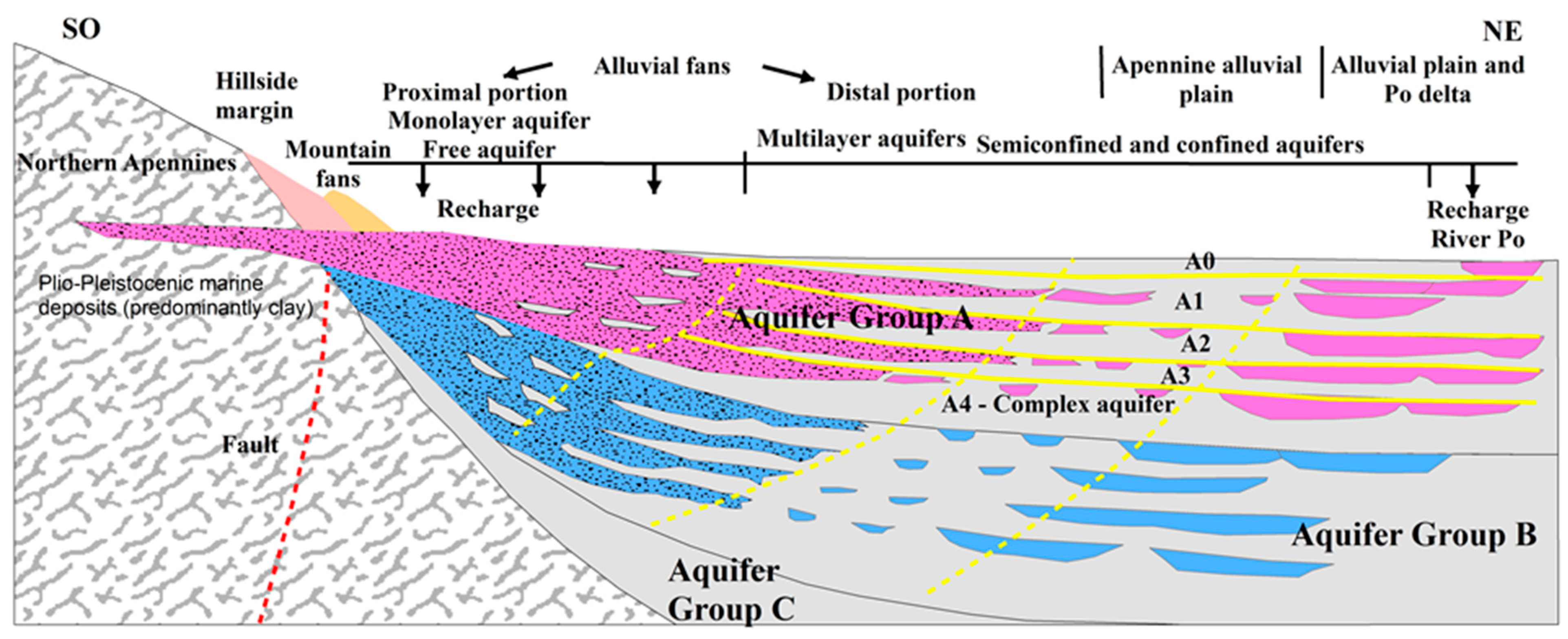
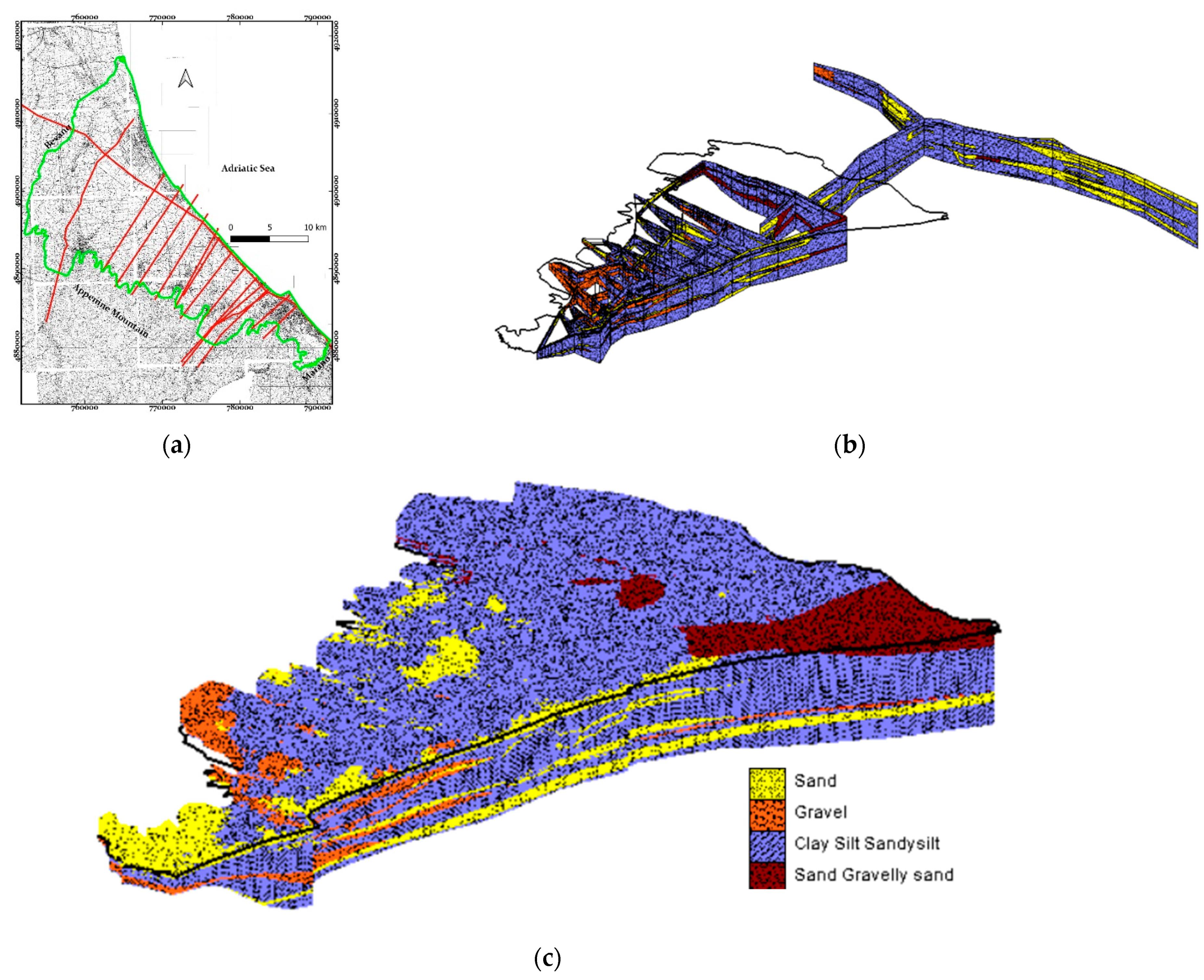


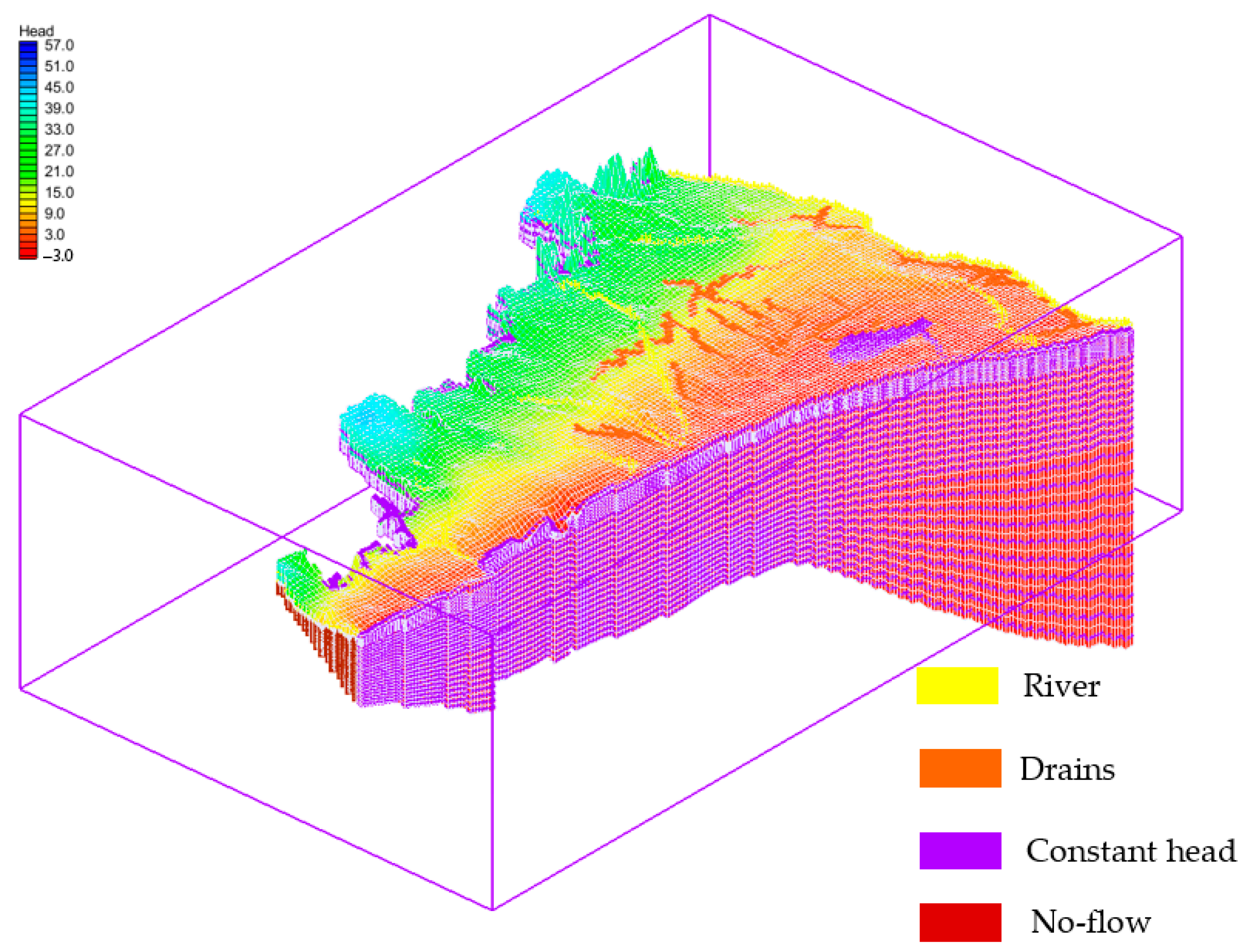
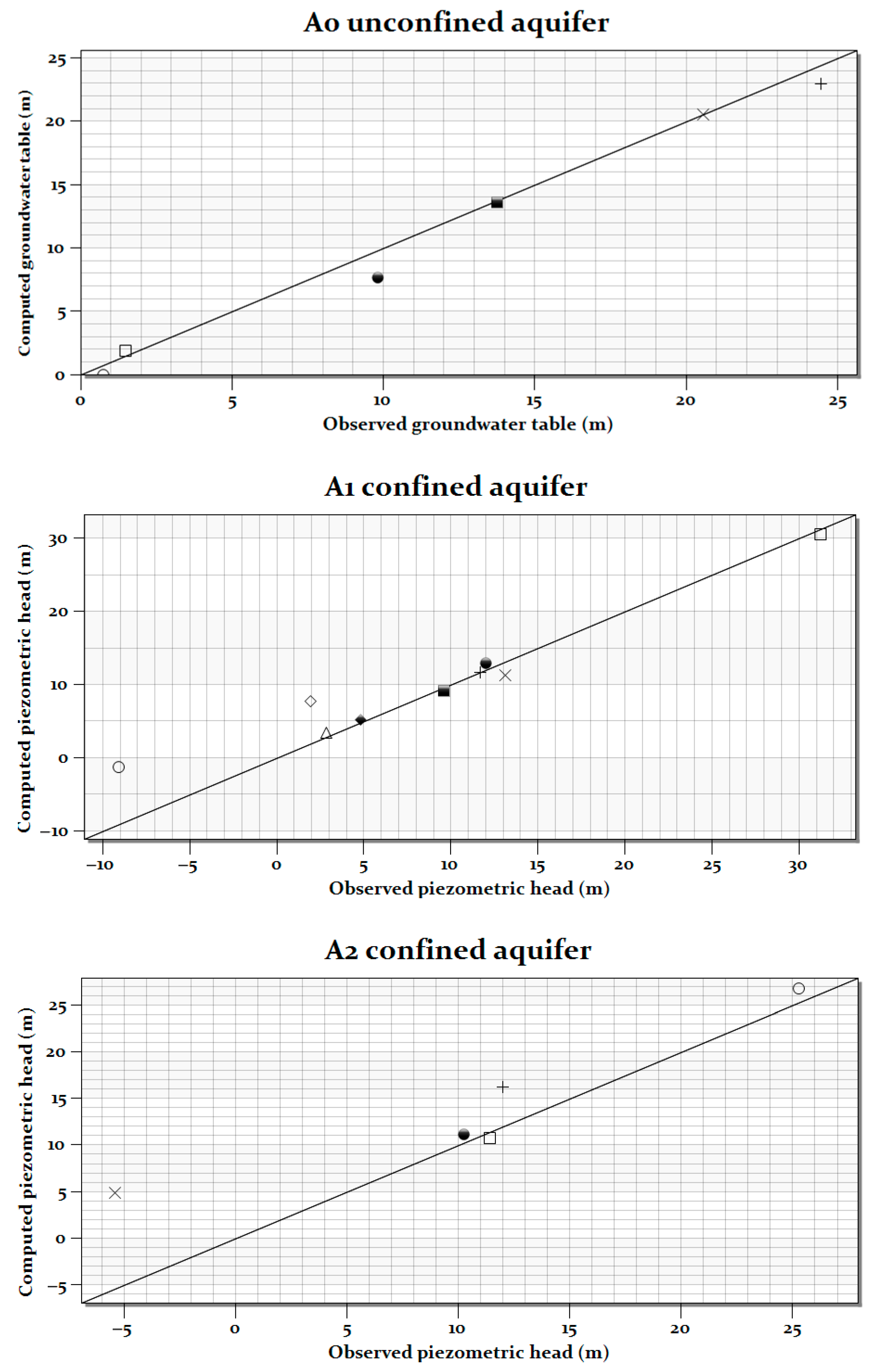


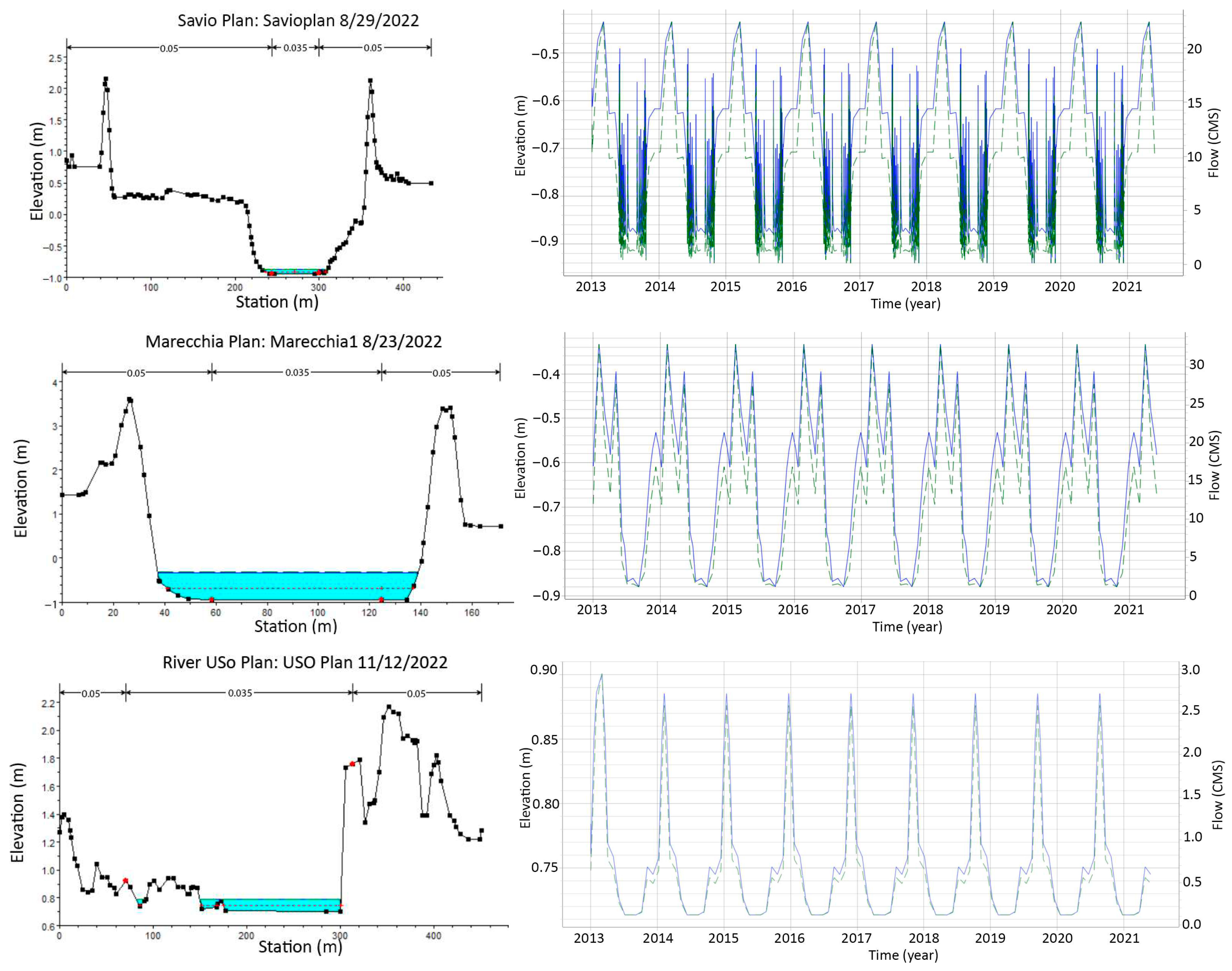
| Name of Basin | Area (km2) | Max Flow (m3s−1) | Min Flow (m3s−1) | Average Flow (m3s−1) | Distance to 0 m River Bed Elevation (m) | Slope | Distance of Monitoring Station to the Sea (km) | Highest Elevation of Basin (m) | Least Elevation of Basin (m) | Estimated Flow at the Cross-Section (m3s−1) | Elevation of Water Stage (m) | Distance to Cross-Section from the Sea (m) |
|---|---|---|---|---|---|---|---|---|---|---|---|---|
| Savio | 585.8 | 574 | 0 | 8.16 | 2326 | 0.0004 | 48.60 | 1361 | −1.03 | 0.11–22.8 | −0.94 to −0.44 | 413 |
| Pisciatello and Rubicone | 172.1 | 106 | 0 | 0.33 | 763 | 0.001 | 10.07 | 469 | −1.02 | 0.46–2.09 | 0.71 to 0.75 | 86 |
| Uso | 109 | 338 | 0 | 0.77 | 337 | 0.0009 | 19.62 | 762 | −0.32 | 0.15–2.57 | 0.71 to 0.78 | 228 |
| Bevano | 334.7 | - | - | - | 1790 | 0.0005 | - | 170 | −0.99 | 8.49–112.31 | 0.04 to 1.3 | 0 |
| Marano | 62.4 | - | - | - | 123 | 0.003 | - | - | −0.4 | 0.3–13.65 | 2.71 to 3.10 | 0 |
| Marecchia | 531.8 | 636 | 0 | - | 407 | 0.002 | 2.39 | 1405 | −1.0 | 1.39–32.99 | −0.88 to −0.33 | 282 |
| Parameter | Value | Unit |
|---|---|---|
| Horizontal hydraulic conductivity | A0: 5.79 × 10−5 to 9.26 × 10−4 A1: 1.16 × 10−5 to 2.45 × 10−3 A2: 1.16 × 10−6 to 4.70 × 10−3 | ms−1 |
| Vertical anisotropy | 1 | (-) |
| Effective porosity | 0.3 | (-) |
| Parameter | A0 Aquifer | A1 Aquifer | A2 Aquifer |
|---|---|---|---|
| Mean error | 0.71 | 1.37 | 3.25 |
| Root-mean-square error | 1.11 | 3.33 | 5.04 |
| EF | 0.98 | 0.89 | 0.73 |
| R | 0.99 | 0.94 | 0.87 |
Disclaimer/Publisher’s Note: The statements, opinions and data contained in all publications are solely those of the individual author(s) and contributor(s) and not of MDPI and/or the editor(s). MDPI and/or the editor(s) disclaim responsibility for any injury to people or property resulting from any ideas, methods, instructions or products referred to in the content. |
© 2023 by the authors. Licensee MDPI, Basel, Switzerland. This article is an open access article distributed under the terms and conditions of the Creative Commons Attribution (CC BY) license (https://creativecommons.org/licenses/by/4.0/).
Share and Cite
Cherubini, C.; Sathish, S.; Pastore, N. Dynamics of Coastal Aquifers: Conceptualization and Steady-State Calibration of Multilayer Aquifer System—Southern Coast of Emilia Romagna. Water 2023, 15, 2384. https://doi.org/10.3390/w15132384
Cherubini C, Sathish S, Pastore N. Dynamics of Coastal Aquifers: Conceptualization and Steady-State Calibration of Multilayer Aquifer System—Southern Coast of Emilia Romagna. Water. 2023; 15(13):2384. https://doi.org/10.3390/w15132384
Chicago/Turabian StyleCherubini, Claudia, Sadhasivam Sathish, and Nicola Pastore. 2023. "Dynamics of Coastal Aquifers: Conceptualization and Steady-State Calibration of Multilayer Aquifer System—Southern Coast of Emilia Romagna" Water 15, no. 13: 2384. https://doi.org/10.3390/w15132384
APA StyleCherubini, C., Sathish, S., & Pastore, N. (2023). Dynamics of Coastal Aquifers: Conceptualization and Steady-State Calibration of Multilayer Aquifer System—Southern Coast of Emilia Romagna. Water, 15(13), 2384. https://doi.org/10.3390/w15132384









